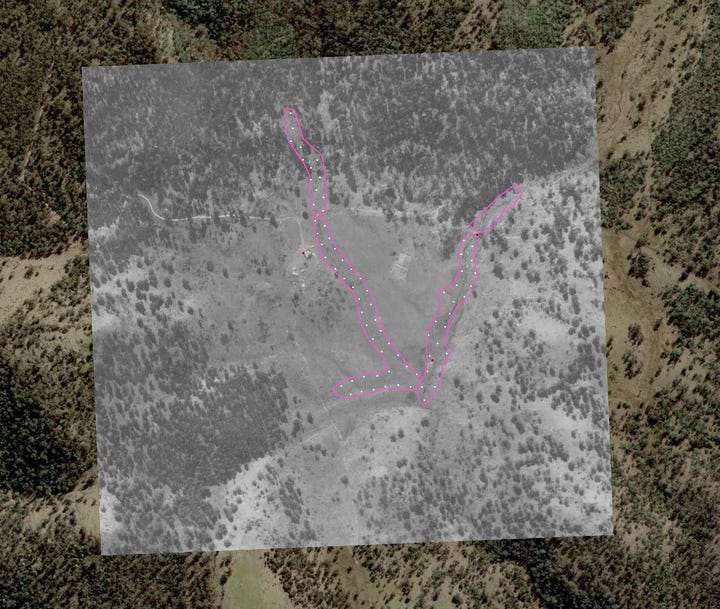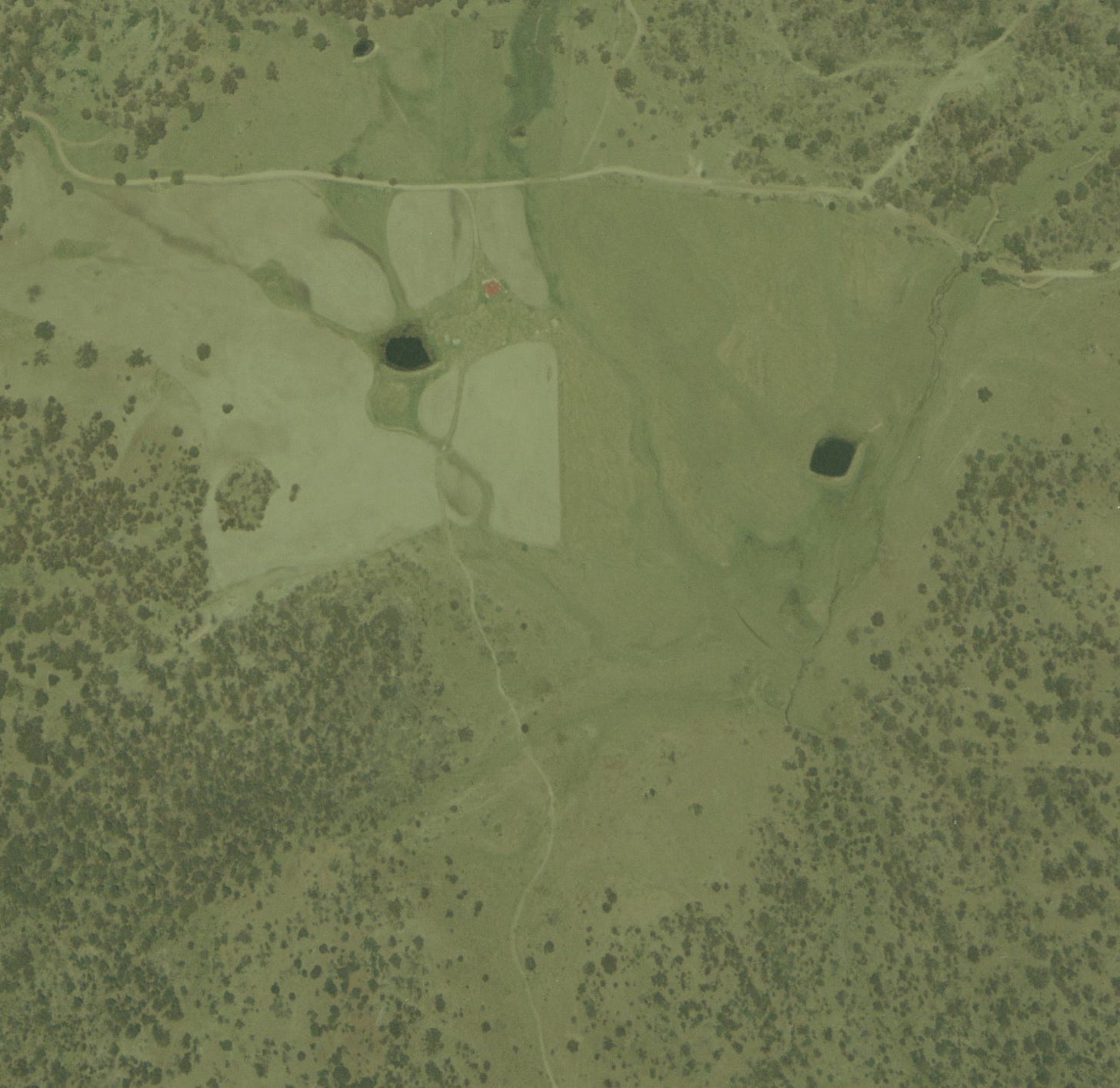How we’re using vegetation islets to improve habitat connectivity
We’re strategically planting small patches of habitat throughout the Honeysuckle Flat restoration zone.
Habitat fragmentation is a major challenge in modern conservation. When large, contiguous ecosystems are broken up into smaller, isolated patches, it disrupts the natural movement of plants and animals across landscapes, and migration, foraging and breeding becomes increasingly difficult.
In response, restoration efforts that focus on enhancing connectivity are critical for providing opportunities for flora and fauna to reoccupy areas that once formed their home range.
At the Quoin, three key areas have experienced significant fragmentation: Honeysuckle Flat, Long and Big Paddocks, and Stocker’s Bottom. These will be the focus of our restoration efforts, starting with Honeysuckle Flat. Here, our aim is to reconnect the landscape and create viable habitats for small mammals.
By focusing on improving connectivity, we aim to restore movement corridors, allowing wildlife to thrive in a landscape that has been altered by land clearing dating back to the mid-1800s.
The vegetation islet approach
To address habitat fragmentation at Honeysuckle Flat, we are using the ‘vegetation islet’ approach, which involves strategically planting small patches of habitat throughout a landscape.
Vegetation islets provide shelter and food for native mammals, helping them avoid predators while also supporting natural regeneration processes. This method draws on the work of Alex Lechner and Edward Charles Lefroy in 2014, as cited by Neil Davidson et al. in 2021, which emphasised the importance of creating smaller, well-connected habitat patches to support fauna movement.
Five advantages of the vegetation islet method
1. Enhanced connectivity in a fragmented landscape
Vegetation islets act as stepping stones, offering refuge for small mammals and other species as they move through the landscape.
2. It avoids a significant maintenance burden that can come with large, fenced restoration areas
Fences around large restoration require ongoing upkeep. But our approach minimises this need by establishing smaller, fenced ‘cages’ around each vegetation islet.
Initially, these cages will protect young vegetation from browsing pressure. But when the plants have grown to a suitable height, small holes will be cut in the fencing to allow smaller mammals access. Eventually, once the stems are well grown and the vegetation is above browse height, the cages will be removed altogether. Depending on how long they’ve been in the field, some materials will be reused to create vegetation islet cages elsewhere as required.
This approach is advantageous in areas with wombats, which are known to dig under fences if the end isn’t in sight, creating access points for other species. At Honeysuckle Flat, wombats will easily be able to walk around our 2 x 2 metre cages, and if they do dig, the breach will create access to one islet, rather than the entire restoration area.
Additionally, the height of the cages will discourage deer from trying to jump over the top.
3. It’s cost-effective
When compared to fencing an entire paddock or restoration zone, using individual vegetation islets improves protection from animals, retains grazing opportunities and connectivity, and is more cost-effective. We estimate that to fence the entire paddock (53.63 ha) would take 3.25 km of fencing. This is very similar to fencing just the restoration zone (6.88 ha) which would require 3.23 km of fencing, as per the figure below. Installing a fence that prevents only deer (not possum or rabbits) is estimated to cost between $33 to $35 per metre (material and labour), resulting in a total cost of more than $100,000 for either the entire paddock or just the restoration zone.
The most expensive option we looked at for fencing our vegetation islets (cylinders that use 3 panels of 2.4 metre x 3.0 metre weldmesh) cost an estimated $23,000 in materials only. The wallaby mesh and star picket option came in under $10,000 for materials only. With labour for each approach estimated at 50% of material costs, even the most expensive vegetation islet option we reviewed is approximately twice as cost-effective — with the added benefits of not having all your eggs in one basket.
4. It’s scalable
The vegetation-islet method not only reintroduces connectivity within the larger 54-hectare restoration zone, but also offers an efficient, scalable solution to reconnecting fragmented landscapes. We’re starting with Honeysuckle Flat, but we intend to take our learnings from this project and apply them to future projects in Big and Long Paddocks and Stocker’s Bottom too.
5. It revegetates the ecosystem in line with what was understood to once be there
Historical aerial imagery of Honeysuckle Flat in 1949 shows scattered trees and shrubs were present, but by 1997, significant land modification had taken place, including the establishment of improved pastures or cropping areas. Further potential evidence that this area was once more wooded than its current state lies with a large root discovered while deep ripping to prepare the ground for planting.
Our islets aim to restore trees and shrubs to to align with what we understand the area to have once looked like.

Practical steps for implementing the vegetation islet approach
1. Planning and site familiarisation
We engaged environmental consultancy EnviroDynamics to develop a restoration plan for The Quoin and an implementation plan for the Honeysuckle Flat restoration zone. This plan has served as the foundation for subsequent planning and experimentation.
2. Mapping the area
Using geographical information systems (GIS), the area surrounding Honeysuckle Flat was mapped by EnviroDynamics to determine where islets would be most effective. When placing the islets, we considered factors including the existing distribution of native vegetation, proximity to seasonal watercourses, and micro-climatic elements such as natural landscape depressions. Our digital twin was an important tool to help assist this process.
We also undertook vegetation surveys and partnered with NatureScan to collect baseline data, so we can track the uplift in biodiversity over time, and to inform a potential future biodiversity credit.
3. Spacing and design
The vegetation islet design is inspired by Greening Australia’s Tasmanian Island Ark project, which demonstrated the success of 2 x 2 metre revegetation cages in restoring patches of vegetation within degraded paddocks. These small, protected vegetation islets serve as stepping stones for species, encouraging their movement through the landscape.
At Honeysuckle Flat, we’ll plant 72 vegetation islets using native species. Each 2 x 2 metre islet will be spaced about 30 metres apart across a 7-hectare zone. This equates to roughly 10 vegetation islets per hectare. This spacing is based on Lechner and Lefroy’s finding that smaller native marsupials will be able to cross distances of up to 30 metres. It will also allow sufficient light penetration to support grassland growth beneath the canopy.
4. Plant selection and groupings
Using a combination of expert advice, field surveying and local knowledge, we developed a list of mid and overstorey plants suitable for Honeysuckle Flat. These species were then grouped according to capacity to deal with water-logging and black cracking clay soils. Each vegetation islet is designed to provide a mix of habitat types, with two local eucalypts and two shrubs surrounded by rushes and grasses like lomandra and silver tussock.
Within some groupings we have hedged our bets by selecting two different overstorey species (e.g. Eucalyptus amygdalina and Eucalyptus pauciflora or Eucalyptus viminalis and Eucalyptus pauciflora). This aims to provide a greater chance of success in the black cracking clay.
We also decided to collect Eucalyptus pauciflora and Eucalyptus ovata seeds for sowing and growing into seedlings (rather than sourcing them from elsewhere) to maximise the chance of local adaptation and ecological resilience. Trees, shrubs and ground covers are being grown by the Derwent Catchment Project’s nursery.
5. Fencing
To protect the young vegetation from grazing animals, each islet will be surrounded by a small 2 x 2 metre cage. This cage will prevent deer, wallabies, kangaroos, wombats and other browsers from damaging the newly planted islets while they establish.
Cage design and costing options were based on initial ideas provided by EnviroDynamics, with further thinking and design ideas developed by The Quoin team.
When designing the cages, we considered:
Their ability to exclude local grazing and browsing animals;
The tools and skills required for construction;
The likelihood of adoption by other landholders based on cost and ease of implementation;
Their durability — ensuring they last approximately 6 years, when the trees will likely be mature and tall enough to withstand browsing;
Whether we could cut holes in the material at a later stage to enable connectivity for smaller mammals;
The overall cost;
The availability of materials from local rural supply stores;
How to maximise cage volume when materials are fixed in length (i.e. weld mesh), to enable more room for plant and shrub growth over a longer period; and
Whether materials would be reusable after the initial installation.
We’re currently in the process of trialling various materials and cage configurations. To date, our biggest challenge has been finding a design that’s both easy to construct and possum-proof. For example, in our initial cage test — which used 4 x star pickets, 90 cm of wide chicken netting, three support wires and a floppy top — it took 5 days for the possums to make their way inside the cage.

6. Site preparation
To prepare for planting, we removed existing fences in the area, and marked the locations of the islets using a tent peg, piece of string and a spray can. We measured approximately 30 metres between each vegetation islet, taking into account the extent of existing native vegetation where the 30 metre mark lay.
We then sprayed each 2 x 2 metre islet with herbicide. Initially, we wanted to use a steam weeder to prepare the beds, but as the ground was still wet in spring, and the steam weeder is towed behind a car on a trailer, this option was determined as too heavy for the conditions. However, a steam weed application in summer and autumn may be feasible in future plantings, depending on access.
Once the ground was dry enough to use a tractor, we undertook deep ripping, before another round of herbicide was applied in late summer to knock down new germinants (new weeds), such as spear thistle, which readily sprouts as soon as ground is disturbed across The Quoin. By spraying two rounds of herbicide, we aimed to speed up root decay of in-situ weeds to help make soil more friable (i.e. crumbly and easier to dig) for planting. The deep ripping aimed to break up subsurface compaction and should improve the speed at which plants become established by making root penetration easier.
After deep ripping, we needed to knock down the edges, and flatten out the vegetation islet ground with a mattock and sturdy rake. This step was crucial in creating a flat, stable base for the construction of the vegetation islet cages. A third spray was recommended, but we are opting for a layer of mulch to help suppress new germinants post ripping. This will be applied in March-April and will not only help retain moisture in the drier times, but also add texture and organic matter.
We also installed long-term reference monitoring posts 10 metres from each vegetation islet on a bearing of 45 degrees north. The intent is to capture images at select intervals (including pre-planting, post planting and then annually) to show change as the project progresses. We’ll also use our fleet of camera traps to monitor how species interact with our islets and subsequent NatureScan surveys to measure an uplift in biodiversity over time.
What’s next?
The next phase of the project involves selecting and building the final cage design, and planting the first batch of vegetation islets in autumn after the first substantial rains. Over the coming months, we’ll be working to establish the plants, monitor their growth, and assess the success of the fencing and habitat restoration efforts.
In terms of timeline, we expect to spend a few weeks in total over a 9-month period preparing and planting the islets, with initial monitoring focusing on their survival and growth over the first year. The islets will remain caged for at least 6 years to ensure the plants have the chance to establish without excessive browsing pressure.
This restoration effort is part of a long-term strategy to enhance biodiversity and connectivity across The Quoin, with Honeysuckle Flat serving as a key pilot site for innovative habitat restoration. It also forms part of a broader program of demonstration at The Quoin — this time showcasing practical restoration methods that others can adapt and implement on their own properties.
Stay tuned for updates as we continue to restore these critical landscapes and connect the dots for wildlife across the property.
This article was written by: Andrew Rettig
And edited by: Bronte McHenry, Karina West, Michael Honey and Lisa Miller
The Quoin is a living laboratory, where we develop and deploy technologies, products and practices to accelerate regeneration at scale.
If you’d like to collaborate, please get in touch.
And to follow more of our nature-positive work, please subscribe to Wedgetail’s newsletter.











